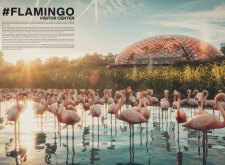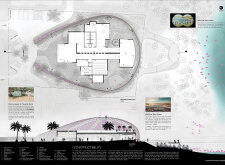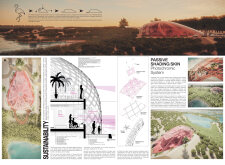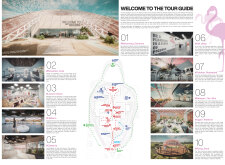5 key facts about this project
The center features a distinctly elongated form that mimics the appearance of a flamingo, serving not only as a functional structure but also as a symbol of the area's ecological heritage. Key design elements include multiple observation platforms that provide visitors with enhanced viewing experiences of the wetlands. These platforms are strategically positioned to facilitate immersion in the environment while ensuring minimal ecological disruption.
Sustainable design is a core principle underlying the project. The use of phototropic panels allows the building to regulate natural light and temperature efficiently, reducing reliance on artificial lighting and energy consumption. Additionally, the extensive use of glass facades enables a seamless visual connection between the interior spaces and the outdoor environment, promoting an atmosphere conducive to education and observation.
Innovative material choices further distinguish this project from typical visitor centers. The structure is primarily framed in steel, providing durability while maintaining a lightweight profile. Natural wood elements have been incorporated into the flooring and outdoor spaces, creating a warm, inviting aesthetic that resonates with the surrounding landscape.
Interactive educational spaces within the center facilitate workshops and programs aimed at fostering community engagement and awareness of local ecological conditions. These areas encourage participation and learning, transforming the visitor experience into an active dialogue about conservation efforts.
Unique to this project is its focus on integrating advanced technologies with ecological principles. The passive shading systems employed allow for dynamic interactions throughout the day, adapting to varying light conditions and enhancing visitor comfort. The architectural approach emphasizes a compact footprint, minimizing environmental impact while maximizing user engagement with the natural surroundings.
This project exemplifies a nuanced understanding of the intersection between architecture and ecology, offering a model for future developments within sensitive environmental contexts. For those interested in exploring the architectural details further, it is encouraged to review the architectural plans, architectural sections, and architectural designs that illustrate the thoughtful ideas underpinning this visitor center.


























